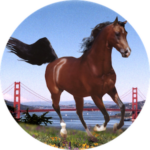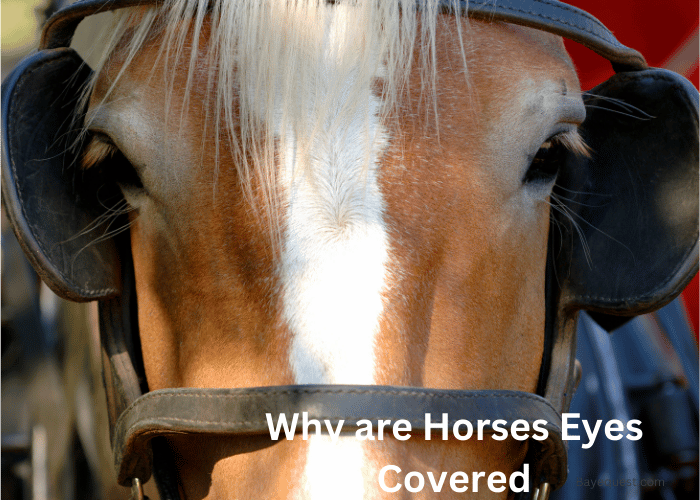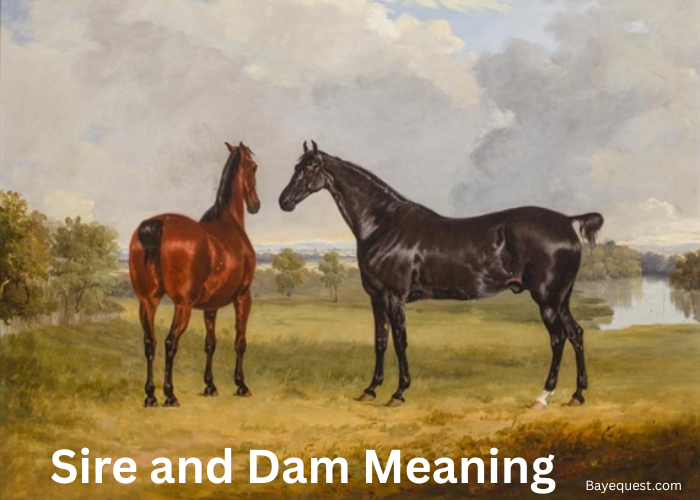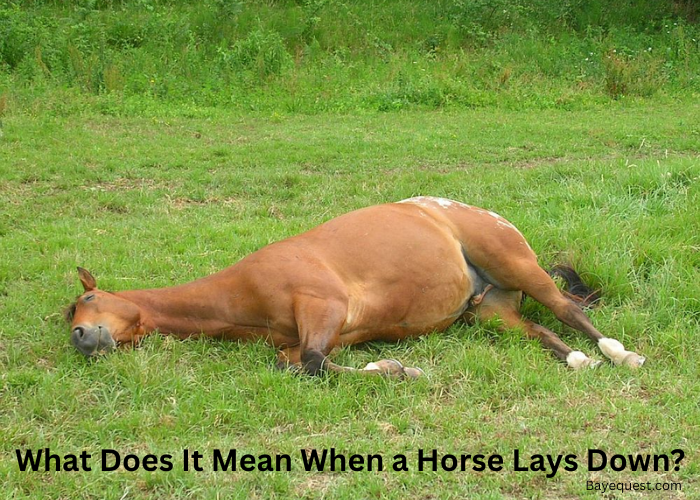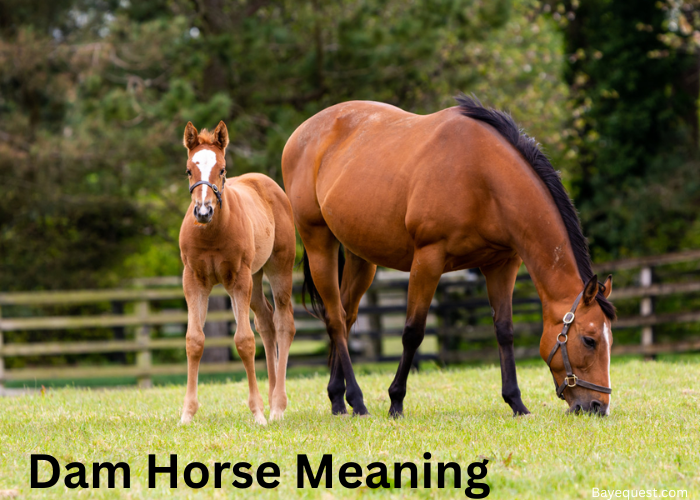Did you know that covering a horse’s eyes can actually be a sign of care? With years of experience in equine therapy and training, I’ve learned that what might seem peculiar at first glance has deep roots in enhancing a horse’s comfort and focus.
Many horse owners and lovers are puzzled by this sight, questioning its cause.
This article aims to shed light on this practice, explaining its benefits and the science behind it. Dive in to understand the thoughtful considerations behind covering horses’ eyes.
Why are Horses Eyes Covered? Key Takeaway
Horse eyes are covered with either blinders or fly masks. Blinders help prevent the horse from spooking and keep it focused by limiting its vision. Fly masks protect the horse’s eyes and face from flies and harsh light. Both ensure the horse’s safety and comfort.
What’s the Cover on a Horse’s Face Called?
When you spot a horse sporting a “cover” over its face, you’re likely observing one of several types: a blinker, visor, blindfold, or fly mask.
Each serves a unique purpose, as we’ll explore shortly. Despite their differences, these face covers share a common goal: to enhance the horse’s vision for better performance.
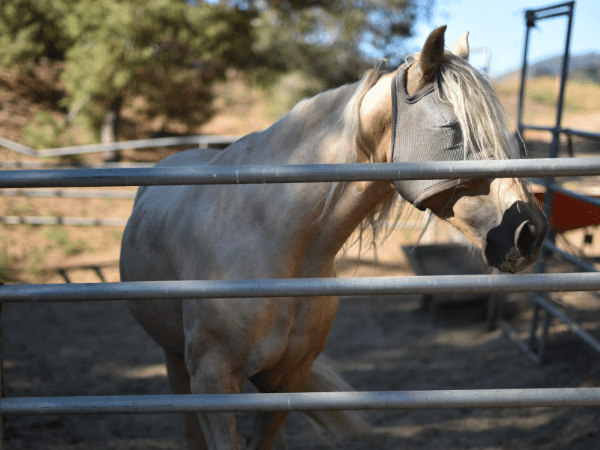
7 Reasons to Cover Horse Eyes
Covering the horse’s eyes helps in many ways, whether at home, on the road, or in the ring. The following are a few reasons why trainers and owners cover their horses’ eyes;
1. To focus their field of vision on what’s ahead
Horses see almost everything around them. Their wide vision helps them spot danger in the wild, but it can be a problem during work or racing.
Too many sights can overwhelm them. That’s where eye coverings, like blinkers, come in.
They block part of the side view and force the horse to look forward. This simple limit helps the animal focus on the path ahead and the rider’s cues.
It keeps them from spooking at movement from the sides. In racing, blinkers help prevent distraction by other horses or the crowd.
In training, they teach focus and discipline. The result is a calmer, more controlled horse that reacts only to what truly matters.
Covering the eyes doesn’t blind them. It trains their attention and keeps them safe when precision and direction count most.
2. To calm them down while traveling
Traveling can be stressful for horses. They’re prey animals with strong flight instincts, and every movement or noise can feel like a threat.
When they’re in a trailer, their balance, vision, and hearing are all challenged.
Covering their eyes helps reduce these triggers. It blocks flashes of light, sudden movement, and passing vehicles that can scare them.
With less visual chaos, their heart rate drops, and they stay calmer. A soft, breathable hood or mask allows them to breathe and blink easily while still limiting what they see.
Handlers often use it before loading, during transport, or when entering busy showgrounds. It’s not about taking sight away, it’s about giving peace.
When a horse can’t see every unfamiliar thing rushing by, it stops reacting to fear. The result is smoother travel, fewer injuries, and a horse that steps off the trailer calm, steady, and ready to perform.
3. Safety and protection
A horse’s eyes are large and exposed, making them easy targets for dirt, dust, and debris. During rides, races, or even on windy days, tiny particles can get into their eyes, causing pain or infection.
Covering their eyes offers a simple layer of defense. Masks, goggles, or hoods act as shields, keeping out harmful elements without blocking vision completely.
This protection is especially important on dusty trails, sandy arenas, or while hauling hay and feed. Even small objects, such as twigs or insects, can cause serious corneal scratches.
Eye coverings prevent that. They also keep water, mud, and road grit from splashing into the face during travel.
For performance horses, protective eyewear improves safety when moving at high speed. It’s a practical way to keep their eyes clean, comfortable, and injury-free.
Protection isn’t about restriction; it’s about preserving one of a horse’s most sensitive senses.
4. To keep flies out of their eyes and face
Flies and gnats love the moisture around a horse’s eyes. They land, bite, and irritate the delicate skin, causing constant twitching and headshaking.
Over time, this can lead to infections like conjunctivitis. Covering the eyes with a fly mask stops that.
These masks are made from fine mesh that lets the horse see clearly while keeping insects out. It’s like wearing sunglasses that protect rather than provide shade.
The mask also covers parts of the face where flies love to gather. That’s around the nose, cheeks, and forehead. Some even include ear covers for full protection.
Horses wearing them stay relaxed, spend more time grazing, and spend less time fighting bugs. During fly season, this simple covering prevents sores, swelling, and stress.
It also stops horses from rubbing their eyes against rough surfaces to get relief. A fly mask keeps their vision clear and their face comfortable all summer long.
Read also: Common Myths About Blue-Eyed Horses.
5. To reduce stress and anxiety
Horses are naturally alert animals. Their wide vision means they notice every shadow, sound, and sudden movement.
While this helps them survive in the wild, it often makes them anxious in busy environments. Covering their eyes helps calm that constant alertness.
When visual distractions disappear, their breathing slows and muscles relax. They no longer react to every flicker of motion or nearby noise.
Trainers use soft eye covers during grooming, shoeing, or when introducing new surroundings. It gives the horse a sense of safety, like a person closing their eyes to rest.
This quiet state helps the horse stay still and focused, especially when something stressful is happening nearby. It’s also useful for nervous or high-strung breeds that tend to overreact.
Reducing what they see reduces what they fear. The result is a calmer, more trusting horse that feels secure even in unfamiliar or crowded places.
6. To help them relax during a procedure
When vets or farriers work on a horse, calm behavior is crucial for safety. But procedures can make horses uneasy. They sense new smells, tools, and movements.
Covering their eyes helps them relax. Without seeing what’s happening, their instinct to flee decreases.
A soft blindfold or towel creates a quiet, dark space that feels safe. The horse focuses less on visual triggers and more on the handler’s voice or touch.
This helps during medical treatments, dental work, or hoof trimming. It also prevents sudden reactions that could hurt both the animal and the handler.
Eye coverings are never tight or harsh. They’re designed to soothe, not restrain. Horses often lower their heads and breathe more slowly once covered.
This calm makes procedures faster, smoother, and less stressful for everyone involved. Simply blocking the view can turn a tense, unpredictable moment into one of quiet cooperation and trust.
7. To protect their sensitive skin from sunburn
Some horses, especially those with pink skin or light coats, are prone to sunburn. The skin around their eyes and muzzle burns easily under direct sunlight.
Over time, it can blister, peel, or even scar. Covering their eyes helps shield these delicate areas from harsh UV rays.
Fly masks with UV protection are most common. They block sunlight but still let the horse see clearly. This small barrier prevents painful burns and long-term damage.
It’s especially important for breeds like Paints, Appaloosas, and light-colored Thoroughbreds.
Protecting the skin also prevents secondary infections that can occur when a horse rubs the sore spots. Even short periods in bright sunlight can cause discomfort for sensitive horses.
A UV mask works like sunscreen —only better. It covers the face completely. The result is a happier, healthier horse with smooth, protected skin that stays free from painful sunburn.
Interesting read: How Do Horses See?
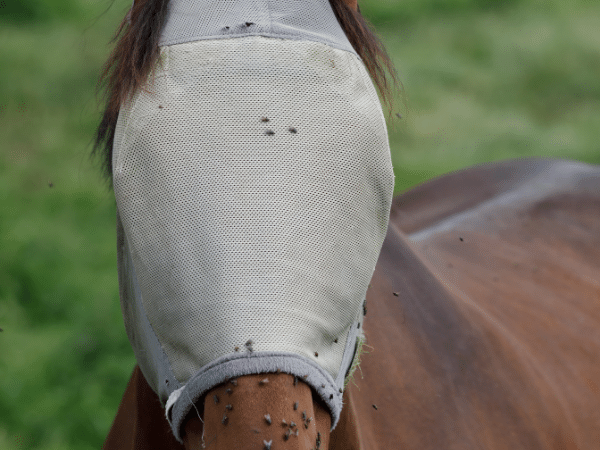
Situations When Horses Wear Blinders
Horses wear blinders in various situations to help keep them focused and calm by restricting their peripheral vision. Horse eye blinders are used when:
1. Racing. Blinders are often used in horse racing to keep horses focused on the track ahead and prevent distractions.
2. Driving. When horses are used to drive carriages or pull wagons, blinders help them concentrate on the path ahead and prevent them from being spooked by traffic, pedestrians, or other distractions.
3. Training. During training sessions, blinders help young or inexperienced horses stay focused on their tasks and avoid easy distractions.
4. Working. Horses used in agricultural work often wear blinders to keep them focused and avoid distractions.
5. Therapeutic riding. In therapeutic riding programs, blinders might help horses remain calm and focused. This provides a safer and more controlled environment for riders with special needs.
6. Trail riding. Some horses may wear blinders on trail rides to help them stay focused and reduce the likelihood of spooking.
7. Parades and public events. Horses participating in parades or public events wear blinders to help them stay calm amidst the noise and crowds.
Types of Horse Eye and Face Covers
There are three main types of horse face covers: fly masks, blinkers, and blindfolds, each with specific uses and benefits.
Fly Masks
Horses are like magnets for flies, attracting them wherever they go. Flies aren’t just annoying; they can rub horses the wrong way, literally, causing irritation and sometimes infections. And it gets worse: some flies carry diseases.
You might consider using sprays to help fight off these pests. They do work, sometimes.
But, be careful; fly sprays can irritate a horse’s eyes, so it’s a no-go for the face. Plus, some flies shrug off the sprays.
That’s where fly masks come in. They’re game-changers, keeping those pesky flies out without bothering the horse. And they’re easy on the wallet too.
When picking a fly mask, go for comfort and ensure it fits right. Look for ones with enough space around the eyes.
Some masks cover the ears and even the muzzle for those who need extra protection. They’re made from mesh or fabric, often with a soft fleece lining around the nose and head, making them comfy for horses.
Related read: How to Prevent Horse Flies.
Blinkers and Visors
Blinkers are special headgear made of leather or plastic cups attached to the harness. They cover the back end of each eye to narrow the field of view.
Thus, the blinker is the most effective tool in improving the horse’s visual focus. It narrows the field of vision, forcing the horse to focus on the objects in front of it. This reduces distraction while improving concentration.
The owner decides how much they with to restrict the horse’s vision. For instance, racers may reduce the visual range from the usual 350 degrees to around 200 degrees, giving the horse a visual range similar to that of humans.
Visors are special blinkers with a small cut in the side that allows the horse to glimpse their surroundings.
It’s most common in racing events, especially if the horse is nervous. The small hole eases their fears by allowing them to view the other horses around them.
Blindfolds
Blindfolds are thick fabric or leather covers that completely block the horse’s vision. A few are also made of plastic.
They are only necessary in extreme cases. The best example is during a fire outbreak. Horses are extremely emotional animals that easily lose their calm in fire situations.
So, you’ll often find rescue teams blindfolding the horse before leading them away. Similarly, some horses form a tight bond with their owners and may act up if you try to separate them.
So, blindfolding is the only solution if you must separate the two.
Finally, blindfolds are invaluable during medical emergencies. Horses are easily spooked in situations such as surgeries, especially with so many new faces around.
Blindfolding shields them from the new experience, keeping them calm throughout the procedure.

How to Safely Cover Your Horse’s Eyes
Unsurprisingly, covering the horse’s eyes, whether fully or partially, isn’t a walk in the park.
As flight animals, they feel greatly threatened if they cannot see. So, they don’t willingly allow anyone to cover their eyes, especially strangers.
The first time, in particular, can be a nightmare. The horse may have a serious overreaction, jumping and kicking with rage.
The following is a step-by-step guide to help you safely blindfold your horse without injury.
Safety First
Halter the horse safely: Never cover the horse’s eyes without haltering them appropriately. More importantly, use reliable halters with no visible weak points.
Hook them onto something: Horses are strong animals that easily overpower grown men. So, it’s best to hook them onto a stationary object. Don’t attempt to cover their face in a wide, open paddock.
Be gentle to avoid injuries: Eye covers can cause injuries if you don’t fit them properly. For instance, twisting the cover around the horse’s face can cause bruises and cuts. Take precautions to avoid injuries.
Except for blindfolds, ensure the horse can see: Designers and manufacturers make highly comfortable covers that allow the horse to graze and move freely when properly fitted. However, the fitting method can completely block the horse’s view. Alternatively, the cover can slide out of position, partially or fully blocking the horse’s view. This increases the horse’s anxiety.
Never blindfold horses for too long: Don’t make it a habit. Instead, blindfold the horse only if you must. Additionally, remove the blindfold once you have accomplished your objectives to spare the horse the trauma.
Step-by-Step Guide to Putting Horse Blinders
The exact steps when putting blinders on a horse vary depending on the type of cover and the design. But the general approach is as follows;
Show them the mask
Horses feel much more comfortable and less spooky if they know what’s coming. So, begin by showing them the face cover.
Different people approach this step differently. A simple method is to stand beside them, facing forward.
Press the nose downward with your right arm to keep the head down. Then use the left arm to raise the mask across their eyes slowly.
Slip the mask from the top
If you’re fitting a full-cover fly mask, start with the ears. Carefully slip the mask over one ear first.
Then, while supporting the horse’s head with one hand, guide the second ear into place. Next, smoothly pass the mask under the horse’s jaw.
Remember to be gentle throughout the process. And avoid standing right in front of the horse; they might accidentally bump you with their head.
Stretch the mask into position
Many people slip up at this step, potentially causing discomfort to the horse. Carefully adjust the mask into place, taking care not to harm the horse’s eyes or fit it too snugly.
A good sign that you’re on the right track is if the horse stays relatively calm during the process. If the horse seems agitated, take a moment to soothe it. If that doesn’t work, it’s best to remove the mask and begin again.
Tighten the mask securely
The face mask can fall off if you don’t tighten it properly. Or worse, it may slide, blocking the horse’s vision. Alternatively, an overly tight face cover can block blood vessels and damage soft cartilage.
Fortunately, most manufacturers provide instructions on how to tighten it properly. Often, it’s tight enough if you cannot slide more than two fingers below the nose piece.
Read also: Why do horses eat manure?
Why do Horses Wear Blinders? FAQs
Can horses see through fly masks?
Yes, horses can see through fly masks. A regular mask is made of semi-transparent material, typically with a mesh that allows the horse to see and hear without difficulty. However, the material may impair the horse’s vision at night. So, plan accordingly and switch to special masks for horses that stay out 24/7.
Is it safe to ride a horse wearing a fly mask?
Yes, it is safe to ride a horse wearing a fly mask, provided the mask fits well and offers clear visibility. Fly masks protect the horse from insects and debris without hindering their sight or comfort, making them ideal for rides during bug-heavy seasons. Always ensure the mask is securely fastened.
How long should you leave a mask on a horse?
You can keep a fly mask on your horse during the day when flies buzz around the most. But take it off at night to give your horse a little break. Also, check regularly for any signs of rubbing or irritation. Make sure the mask is clean and fits just right, so your horse stays comfy.
Why do They Cover Horses Eyes? Conclusion
Horses sometimes wear eye covers for safety reasons. Also, some covers narrow the horse’s range of vision, improving focus when riding through busy environments.
Or, you may blindfold the horse during a medical procedure. However, only use special face covers to minimize anxiety and the risk of injury.
